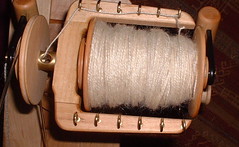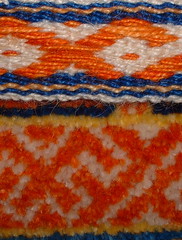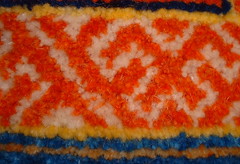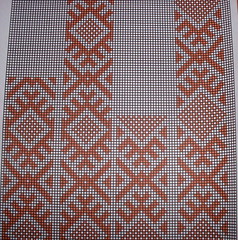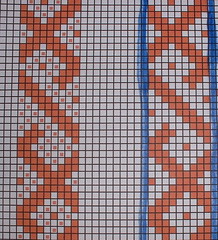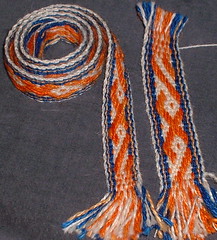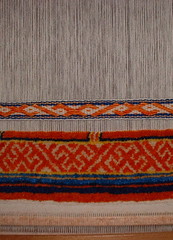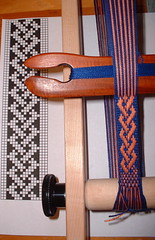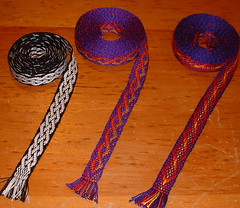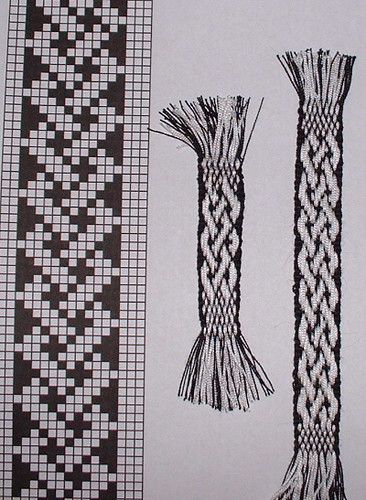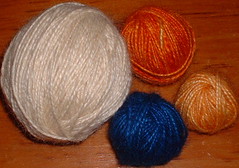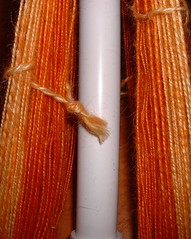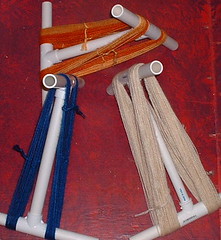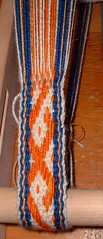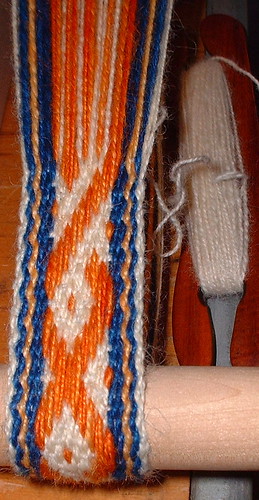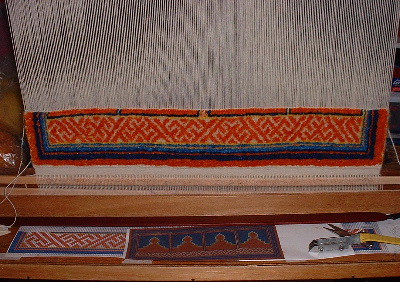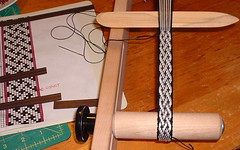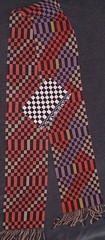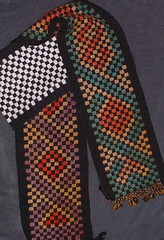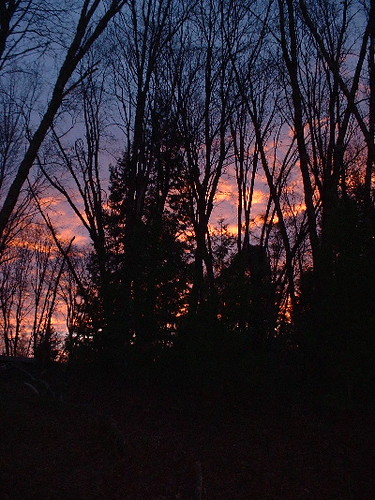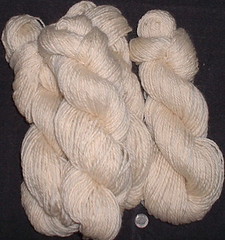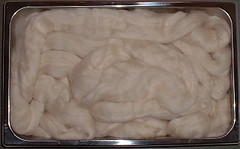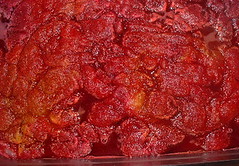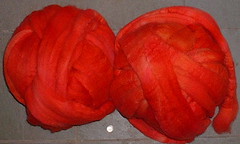Dye Another Day
Busy we were.
Nancy came up for a workshop, and we knitted and dyed. The reknitting comes later, watch this space.
First we were treated to Nancy's Table O' Samples:
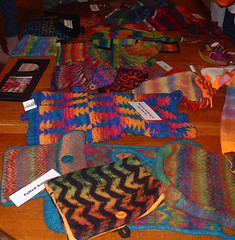
(which we messed up even before she explained what each area was)
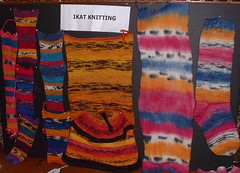
Here's a preview of what we were looking forward to:
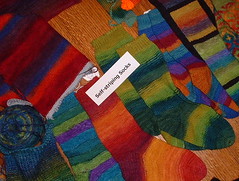
Self striping sock yarns. Of our own. Our own choice of yarn, our own colors. We were like pigs in mud, wiggling with happiness.
So we began. We set up the knitting machines Nancy brought, we attached yarn, and threw the carriage back and forth (I was remonstrated for going too fast. Me?) See how serene Sue is:
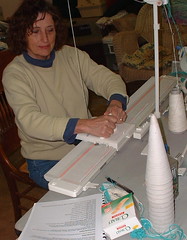
(note the box of band aids! Danger ahead!)
Sue2, diligent, cheerful, and with proper posture:
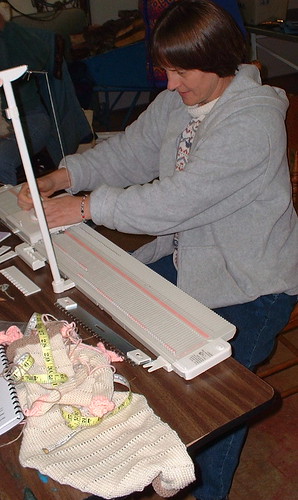
Patricia, here just finishing off a sock blank, with a pile of blanks to her right, ready for dyeing:
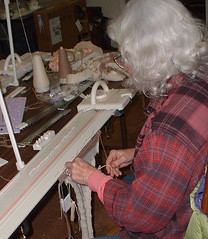
And these? My knitting. This is not what it is supposed to look like (anarchy reigned) but I saved them anyway. They will be fine. Trust me (famous last words):
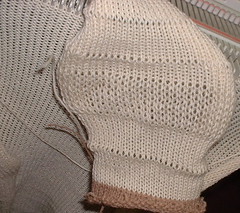
I'm not sure if we were Nancy's most demanding class, or if this is par for the machine knitting course: we kept her running as stitches were dropped, carriages stuck, and whole knitting dropped to the floor. We ripped, we knit again, we prevailed, and beat those little machines into submission. We had blanks.
Day two: We dyed.
Patricia was the only non-dyer among us, and she listened diligently, did all the math, and dyed her sock blank these beautiful melon colors:
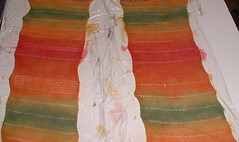
Once Nancy felt like we had a grip on the process, she left, to beat the ski traffic home. And then chaos reigned. Numbers went out the window, we no longer weighed and measured, mutiny occurred.
These are my sock blanks. The colors? Whatever anyone had left in their cups. We were mixing fools:
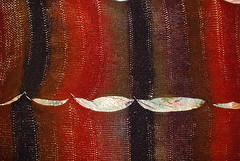
Perilously close to camoflage colors: so me (not!). But they are socks, lowly socks, experiments, as it were.
Dyes were mixed and traded, and paint brushes wielded. Knitting was painted. Knitting was steamed. We even unwrapped and washed the blanks, before they cooled. Zoot alors!
Lindsey, whose previous mop up skeins were published in this post, did mop up skeins, and mop up blanks. Things got a little competitive though, as we all started using knitted blanks for mop ups: Lindsey got fewer and fewer of the spills. So she got creative, and painted in a variety of ways. I'll wait until I get shots of the finished knitting to go into more details, but it was fun, and she was inventive.
The steamer was turned off, bundles were sorted, some even rinsed, and the wine came out. We flopped down in a stupor. Two days, knitting and dyeing, pot luck lunches and dinners out, ending with wine. I tell you, I'd pay to do this. Ooops! I did.
Nancy came up for a workshop, and we knitted and dyed. The reknitting comes later, watch this space.
First we were treated to Nancy's Table O' Samples:

(which we messed up even before she explained what each area was)

Here's a preview of what we were looking forward to:

Self striping sock yarns. Of our own. Our own choice of yarn, our own colors. We were like pigs in mud, wiggling with happiness.
So we began. We set up the knitting machines Nancy brought, we attached yarn, and threw the carriage back and forth (I was remonstrated for going too fast. Me?) See how serene Sue is:

(note the box of band aids! Danger ahead!)
Sue2, diligent, cheerful, and with proper posture:

Patricia, here just finishing off a sock blank, with a pile of blanks to her right, ready for dyeing:

And these? My knitting. This is not what it is supposed to look like (anarchy reigned) but I saved them anyway. They will be fine. Trust me (famous last words):

I'm not sure if we were Nancy's most demanding class, or if this is par for the machine knitting course: we kept her running as stitches were dropped, carriages stuck, and whole knitting dropped to the floor. We ripped, we knit again, we prevailed, and beat those little machines into submission. We had blanks.
Day two: We dyed.
Patricia was the only non-dyer among us, and she listened diligently, did all the math, and dyed her sock blank these beautiful melon colors:

Once Nancy felt like we had a grip on the process, she left, to beat the ski traffic home. And then chaos reigned. Numbers went out the window, we no longer weighed and measured, mutiny occurred.
These are my sock blanks. The colors? Whatever anyone had left in their cups. We were mixing fools:

Perilously close to camoflage colors: so me (not!). But they are socks, lowly socks, experiments, as it were.
Dyes were mixed and traded, and paint brushes wielded. Knitting was painted. Knitting was steamed. We even unwrapped and washed the blanks, before they cooled. Zoot alors!
Lindsey, whose previous mop up skeins were published in this post, did mop up skeins, and mop up blanks. Things got a little competitive though, as we all started using knitted blanks for mop ups: Lindsey got fewer and fewer of the spills. So she got creative, and painted in a variety of ways. I'll wait until I get shots of the finished knitting to go into more details, but it was fun, and she was inventive.
The steamer was turned off, bundles were sorted, some even rinsed, and the wine came out. We flopped down in a stupor. Two days, knitting and dyeing, pot luck lunches and dinners out, ending with wine. I tell you, I'd pay to do this. Ooops! I did.
